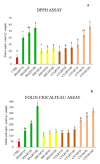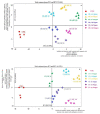Evaluation of Sustainable Recycled Products to Increase the Production of Nutraceutical and Antibacterial Molecules in Basil Plants by a Combined Metabolomic Approach
- PMID: 36771598
- PMCID: PMC9919386
- DOI: 10.3390/plants12030513
Evaluation of Sustainable Recycled Products to Increase the Production of Nutraceutical and Antibacterial Molecules in Basil Plants by a Combined Metabolomic Approach
Abstract
Background: An important goal of modern medicine is the development of products deriving from natural sources to improve environmental sustainability. In this study, humic substances (HS) and compost teas (CTs) extracted from artichoke (ART) and coffee grounds (COF) as recycled biomasses were employed on Ocimum basilicum plants to optimize the yield of specific metabolites with nutraceutical and antibacterial features by applying sustainable strategies.
Methods: The molecular characteristics of compost derivates were elucidated by Nuclear Magnetic Resonance spectroscopy to investigate the structure-activity relationship between organic extracts and their bioactive potential. Additionally, combined untargeted and targeted metabolomics workflows were applied to plants treated with different concentrations of compost extracts.
Results: The substances HS-ART and CT-COF improved both antioxidant activity (TEAC values between 39 and 55 μmol g-1) and the antimicrobial efficacy (MIC value between 3.7 and 1.3 μg mL-1) of basil metabolites. The metabolomic approach identified about 149 metabolites related to the applied treatments. Targeted metabolite quantification further highlighted the eliciting effect of HS-ART and CT-COF on the synthesis of aromatic amino acids and phenolic compounds for nutraceutical application.
Conclusions: The combination of molecular characterization, biological assays, and an advanced metabolomic approach, provided innovative insight into the valorization of recycled biomass to increase the availability of natural compounds employed in the medical field.
Keywords: antibacterial properties; antioxidant capacity; metabolomics; phenolic compounds; recycling biomasses.
Conflict of interest statement
The authors declare no conflict of interest.
Figures






References
-
- Huiart L., Bouhnik A.D., Rey D., Rousseau F., Retornaz F., Meresse M., Giorgi R. Complementary or Alternative Medicine as Possible Determinant of Decreased Persistence to Aromatase Inhibitor Therapy among Older Women with Non-Metastatic Breast Cancer. PLoS ONE. 2013;8:e81677. doi: 10.1371/journal.pone.0081677. - DOI - PMC - PubMed
-
- Thirumurugan D., Cholarajan A., Raja SS S., Vijayakumar R. An Introductory Chapter: Secondary Metabolites. In: Vijayakumar R., Raja S.S., editors. Secondary Metabolites-Sources and Applications. IntechOpen; London, UK: 2018. - DOI
-
- Datta R., Sharma A.K., Thakur A., Datta R., Sharma A., Thakur A. Secondary Metabolites from Plants: Role in Plant Diseases and Health Care. In: Sharma A.K., Sharma A., editors. Plant Secondary Metabolites. Springer Nature; Singapore: 2022. pp. 355–369. - DOI
LinkOut - more resources
Full Text Sources
Molecular Biology Databases
Research Materials

